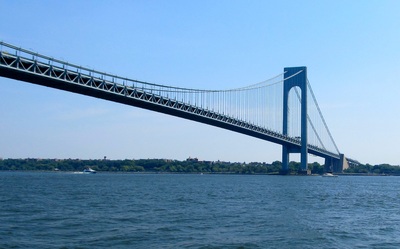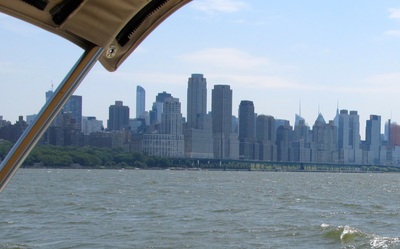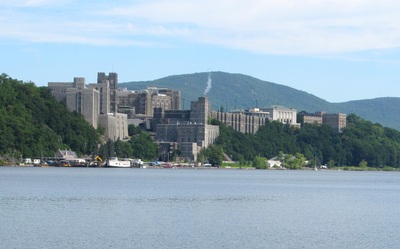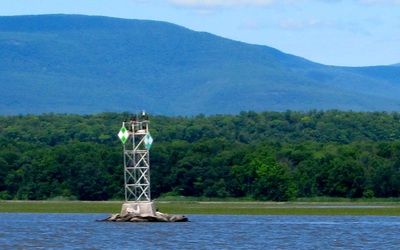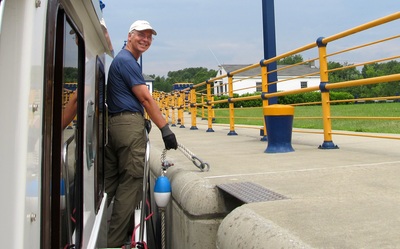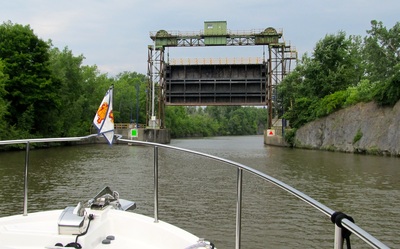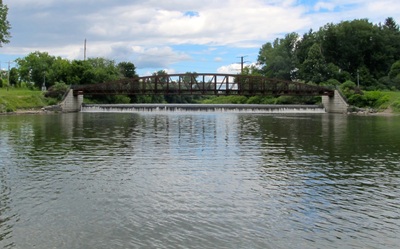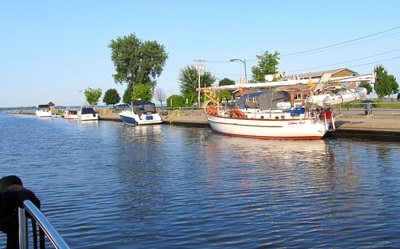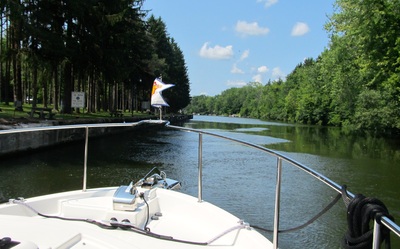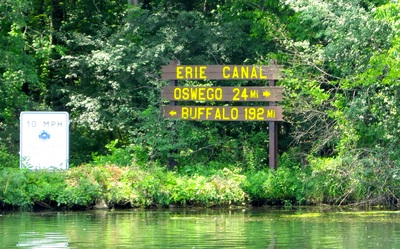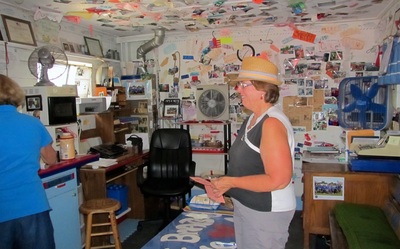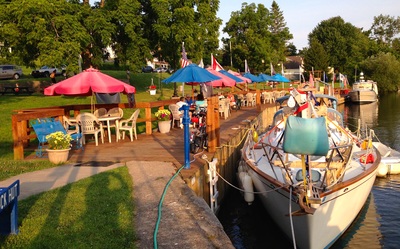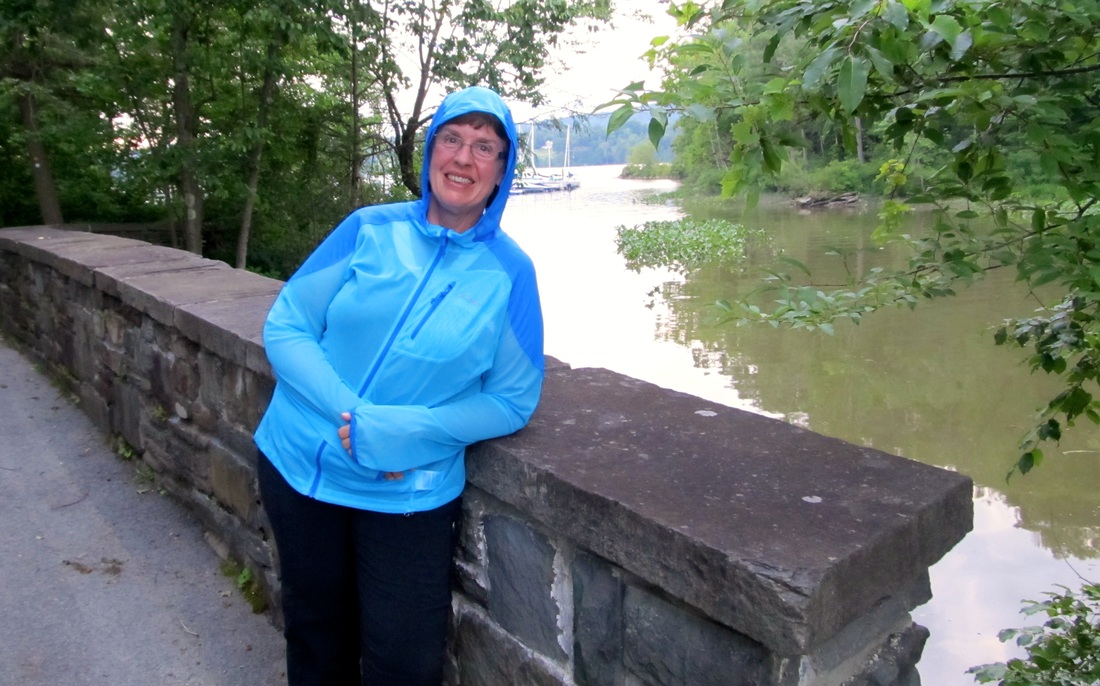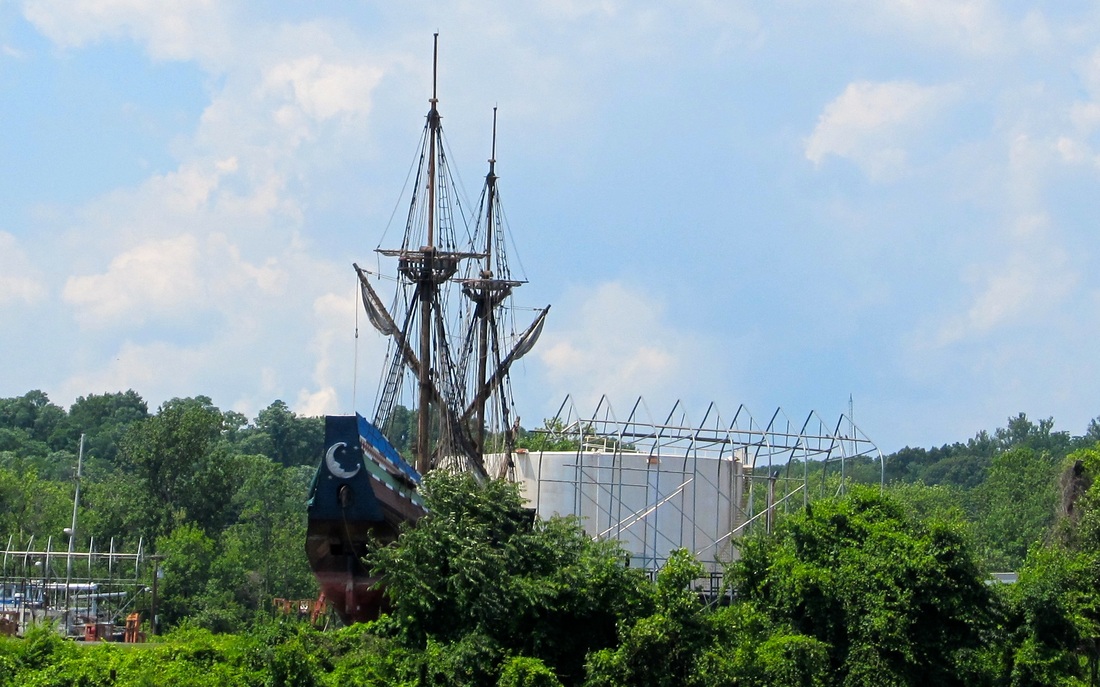Monday, July 7
The fresh wind stayed from the southwest all night and was light by sunrise. After breakfast, various boat-chores were done including repairing a zipper that had ripped away from the canvas by Hurricane Arthur. At 0930 hours, the anchor was pulled and the tug was underway to time the currents in New York Harbor and the Hudson River
90 minutes later, Andiamo was just outside the main shipping channel and going under the narrows bridge that forms the entrance to the main New York Harbor and the Manhattan skyline was in the distance. Throughout our cruise within the jurisdiction of New York City there was the constant presence of security by either Coast Guard patrol boats, the New York PD boats or one of the police department’s helicopters.
Laurie offered a bit teaching on the history of New York from her research. The five burroughs were counties containing many small towns within them. New York City consolidated them into one central identity and executive branch though the legislative side was kept reasonably intact. Thus, they became the biggest dog on the block that stopped most of the in-fighting and competition for resources and the political distractions that often limits local governments from being more than they are.
At 1200 hours, Andiamo passed the Statue of Liberty that was a buzz with tourist boats and at least a thousand people were on the shore. The Manhattan skyline is so familiar from the thousands of images broadcast on the media but the density, the height and variety of shapes, colors, textures and designs was still impressive. In many ways, culturally, economically, and politically, New York City can be described as the center of the North American universe. When it is seen up close for the first time, it is understood why it is an attractive target for the terrorist.
After the Statute of Liberty, the Hudson River is the waterway. The water was choppy from the wind and current and no speed limit means steep and frequent wakes. The commercial marine radio channel was busy with the announcement of freighters and barges moving. We stayed on the New Jersey side of the channel to see the whole view of Lower and Upper Manhattan with its layers of skyscrapers, piers, water taxis, helicopters buzzing overhead, cruise ships and even a three story high golf driving range that is over the water and surrounded by nets. Here, the water had calmed down. The Hudson River is the line between the wealth of money, design, opportunity and talent that is in Manhattan and what is on the Jersey side: the deterioration, missed opportunities, bad decisions and often the opposite of what makes New York different.
Continuing northward at 8 MPH, at 1400 hours the tug reached the tip of Manhattan Island and left New York City proper and passed by communities Cloisters, Riverdale, Yonkers and names from stories and movies. The river is widening and Andiamo is riding a flooding current that only a few miles in front is slack or opposing us.
The fresh wind stayed from the southwest all night and was light by sunrise. After breakfast, various boat-chores were done including repairing a zipper that had ripped away from the canvas by Hurricane Arthur. At 0930 hours, the anchor was pulled and the tug was underway to time the currents in New York Harbor and the Hudson River
90 minutes later, Andiamo was just outside the main shipping channel and going under the narrows bridge that forms the entrance to the main New York Harbor and the Manhattan skyline was in the distance. Throughout our cruise within the jurisdiction of New York City there was the constant presence of security by either Coast Guard patrol boats, the New York PD boats or one of the police department’s helicopters.
Laurie offered a bit teaching on the history of New York from her research. The five burroughs were counties containing many small towns within them. New York City consolidated them into one central identity and executive branch though the legislative side was kept reasonably intact. Thus, they became the biggest dog on the block that stopped most of the in-fighting and competition for resources and the political distractions that often limits local governments from being more than they are.
At 1200 hours, Andiamo passed the Statue of Liberty that was a buzz with tourist boats and at least a thousand people were on the shore. The Manhattan skyline is so familiar from the thousands of images broadcast on the media but the density, the height and variety of shapes, colors, textures and designs was still impressive. In many ways, culturally, economically, and politically, New York City can be described as the center of the North American universe. When it is seen up close for the first time, it is understood why it is an attractive target for the terrorist.
After the Statute of Liberty, the Hudson River is the waterway. The water was choppy from the wind and current and no speed limit means steep and frequent wakes. The commercial marine radio channel was busy with the announcement of freighters and barges moving. We stayed on the New Jersey side of the channel to see the whole view of Lower and Upper Manhattan with its layers of skyscrapers, piers, water taxis, helicopters buzzing overhead, cruise ships and even a three story high golf driving range that is over the water and surrounded by nets. Here, the water had calmed down. The Hudson River is the line between the wealth of money, design, opportunity and talent that is in Manhattan and what is on the Jersey side: the deterioration, missed opportunities, bad decisions and often the opposite of what makes New York different.
Continuing northward at 8 MPH, at 1400 hours the tug reached the tip of Manhattan Island and left New York City proper and passed by communities Cloisters, Riverdale, Yonkers and names from stories and movies. The river is widening and Andiamo is riding a flooding current that only a few miles in front is slack or opposing us.
Andiamo passed land that had real elevation and was the first time on this trip where the elevation had been more than 100 feet for the past 2,400 miles. Tallman Mountain State Park rises out of the Hudson River with the grandeur of trees and steep cliffs. Also, Andiamo left true sea water behind for months to come, a stark contrast from being on the Atlantic and offshore just yesterday.
25 miles from the Statue of Liberty, Sing-Sing Prison was passed and the origin of the phrase, “Being sent up the river” was learned.
The destination was Half Moon Bay Marina on thee east side of the river at community of Croton on Hudson. The marina is a condo community that rents out the vacant slips to transients and was found on Active Captain.com. Steve, the talkative and energetic dockmaster put Andiamo on the long floating guest dock that is next to the wooden breakwater. This breakwater would play a role in what would happen later. It is built of heavy, pressure treated beams and boards, set an angle, with 2 inch gaps between the boards to allow the pressure of the river's urge to go through.
Andiamo had traveled 55 miles in seven hours. We had a light dinner in the cockpit where the mid-80’s temperature and the very high humidity was more tolerable.
Just before bed, the WeatherBug app foretold a line of thunderstorms that was bearing down on the region. The dock lines were checked and the windows were closed. The rain woke us up after midnight but the sudden wind from the north was startling because Andiamo started pitching wildly from side to side as the two to three foot swells, magnified by the 5 mile fetch of the river, came through the gaps of the breakwater. The floating dock was jumping up and down as the swells passed under. The tug strained hard at the lines that tightened just at the end of the arc of her pitch. Thankfully, if the lines had been tighter, a line or cleat could have broken loose over the 60 minutes of tremendous force. Then, just as suddenly, the wind was gone and the water lay down.
25 miles from the Statue of Liberty, Sing-Sing Prison was passed and the origin of the phrase, “Being sent up the river” was learned.
The destination was Half Moon Bay Marina on thee east side of the river at community of Croton on Hudson. The marina is a condo community that rents out the vacant slips to transients and was found on Active Captain.com. Steve, the talkative and energetic dockmaster put Andiamo on the long floating guest dock that is next to the wooden breakwater. This breakwater would play a role in what would happen later. It is built of heavy, pressure treated beams and boards, set an angle, with 2 inch gaps between the boards to allow the pressure of the river's urge to go through.
Andiamo had traveled 55 miles in seven hours. We had a light dinner in the cockpit where the mid-80’s temperature and the very high humidity was more tolerable.
Just before bed, the WeatherBug app foretold a line of thunderstorms that was bearing down on the region. The dock lines were checked and the windows were closed. The rain woke us up after midnight but the sudden wind from the north was startling because Andiamo started pitching wildly from side to side as the two to three foot swells, magnified by the 5 mile fetch of the river, came through the gaps of the breakwater. The floating dock was jumping up and down as the swells passed under. The tug strained hard at the lines that tightened just at the end of the arc of her pitch. Thankfully, if the lines had been tighter, a line or cleat could have broken loose over the 60 minutes of tremendous force. Then, just as suddenly, the wind was gone and the water lay down.
Five MORE Days on the Hudson River
Tuesday, July 8,
The rental car that was reserved the night before was ready for when the Enterprise office was open. The office was less than a mile from the marina and the driver was waiting for us in the marina parking lot. The decision as made to fill the propane tank on this day of exploration and shopping. The 10 pound or 2.83 gallon propane tank was a 1/3 full and was last filled in Charleston just before Easter. Not counting the time that we were in Seattle, the tank was used multiple times a day for 9 weeks and probably could have lasted another 2 to 3 more. The effectiveness and efficiency of propane as a cooking fuel is excellent.
The rental car needed fuel for the day and that led to an adventure of exploring Peekskill and its side streets. Though only 30 miles from New York City, this was rural country that was dotted with small towns and connected by two or four lane highways that turned and twisted through the valleys and were cut into the sides of the hills. Nearly every town had the word “kill” in it; Great Kill Harbor, Fishkill, Peekskill, etc. Our Pacific Northwest naiveté suggested death and battle were here. Wrong. “Kill” is a derivative of a Dutch word for stream or river. This is the land of streams and rivers.
The destinations were the park service historical sites in Hyde Park, the Roosevelt Home and Presidential Library and Eleanor Roosevelt’s home. Along the way, propane would be searched for and a shopping stop to the West Marine Store in West Haverstraw for the life jacket CO2 cylinder and ball fenders for the Erie Canal.
Through Fishkill and Poughkeepsie, the FDR Home National Historical Site in Hyde Park was arrived in time for a ranger-led tour. We would spend 3 hours between the home and the amazing exhibits at the Presidential Library. Knowing little about Roosevelt, we came with away with an appreciation for his optimism in the face of struggles with polio and how his policies polarized the people. Caring for the unwanted, the poor and those with huge disadvantages versus individual responsibility, the market place and the notion that big government is bad government. Roosevelt talked of four freedoms: freedom of speech, freedom of worship, freedom from want, and freedom from fear. Also we appreciated his ability to connect with the common people despite his birth into wealth and being an American aristocrat. He died at 63 years old, less than a handful of years older than us and what he accomplished was amazing, and he looked much older than his years.
Our search for propane took an hour, used two iPhones at the same time, and one dead end search, but the exploration was interesting. Drove past the West Point Military Academy but it was too late in the day to see the visitor center. Then, we were on to the community of West Haverstraw that had the only West Marine store in 50 miles. What it was doing here, versus in Poughkeepsie was beyond us and was not explainable by the store manager.
Before ending that day back at the marina, a large grocery provisioning was done and Memphis style BBQ rib dinner was taken back to the boat for a late dinner. A repeat of the thunderstorms came earlier than the previous night. In the middle of the wind and rain, the National Weather Service issued a severe storm warning that included a possible tornado. None of that happened and we were thankful. Midnight, temperature was in the low 80’s with a very high humidity.
The next day, after Laurie returned the rental car at 7:30 AM, Andiamo was moved for a pump-out of the holding tank. Loosening the cap off of the deck fitting to the holding tank, we experienced the first scene of what became known as, “The Hudson River Sh_t Show.” The second scene of this show would debut on the following day. The details this show are left to the imagination but visualize a full holding tank that is, unknowingly, under pressure and as the cap is turned the pressure is released, propelling a mixture of the contents in all directions, followed by a bubbling volcano that would last a few more seconds. In the frenzy to move away, evade and defend the body parts, the deck cap went over the side. The cause of this is better explained in the Operations, Maintenance and Lessons Learned page of this website.
After we recovered and completed the cleaning, Andiamo rode the calm and flat waters, with the flooding current at 9 MPH onward through the rolling hills of rural and country living, with railroad tracks on both sides of the river. One track was for freight trains that pulled strings of cars at least a mile long. The east track was for the passenger trains, predominately Amtrak that zipped along the curving shoreline.
The West Point Military Academy occupies a dominant geological point where the river makes a sharp turn. Undoubtedly, the site of a former fort that guarded the river, the academy is compact cluster of huge granite buildings on the hillside. The buildings made an ominous and serious image. Sing-Sing Prison looked friendlier than West Point. During the revolutionary war, the Continental Army strung a heavy chain across the river to keep the British from using it. The idea of the chain probably did more than the chain itself.
White’s Marina is a boatyard, a marine store and had a short dock off of the rocky shore. The depth at the dock was 65 feet. Docking at this short dock in wind and current was probably like a pilot landing on an aircraft carrier; it felt like a postage stamp. The store was well stocked and the wise and elderly woman knew her inventory. She pointed me to the right deck cap and we were off.
The river was quiet, seeing only five boats in five hours. At Poughkeepsie, except for the park in downtown, the shoreline was dotted with rusted and abandoned shell from the last century’s industry. Like surfing a wave, Andiamo was keeping up with the moving peak of the flooding current.
The destination was Norrie State Park and Marina, a small harbor that is tucked behind a point and marked with two PVC pipes. The harbor looked full with small to medium sized power and sailboats. Apparently, this state park offers a deal in seasonal moorage. The dockmaster waved us over to the end of a new dock and several locals stood by to catch lines as the building wind from the south wanted to keep the tug off the dock.
We settled in and waited for the next round of thunderstorms that was coming in a line across the region. Weatherbug sent out an alert for this region for high winds and damaging hail. The dark clouds passed to the south of the tug leaving only gusting winds and rain that would come later.
The tug had traveled 49 miles in 6 hours.
The rental car that was reserved the night before was ready for when the Enterprise office was open. The office was less than a mile from the marina and the driver was waiting for us in the marina parking lot. The decision as made to fill the propane tank on this day of exploration and shopping. The 10 pound or 2.83 gallon propane tank was a 1/3 full and was last filled in Charleston just before Easter. Not counting the time that we were in Seattle, the tank was used multiple times a day for 9 weeks and probably could have lasted another 2 to 3 more. The effectiveness and efficiency of propane as a cooking fuel is excellent.
The rental car needed fuel for the day and that led to an adventure of exploring Peekskill and its side streets. Though only 30 miles from New York City, this was rural country that was dotted with small towns and connected by two or four lane highways that turned and twisted through the valleys and were cut into the sides of the hills. Nearly every town had the word “kill” in it; Great Kill Harbor, Fishkill, Peekskill, etc. Our Pacific Northwest naiveté suggested death and battle were here. Wrong. “Kill” is a derivative of a Dutch word for stream or river. This is the land of streams and rivers.
The destinations were the park service historical sites in Hyde Park, the Roosevelt Home and Presidential Library and Eleanor Roosevelt’s home. Along the way, propane would be searched for and a shopping stop to the West Marine Store in West Haverstraw for the life jacket CO2 cylinder and ball fenders for the Erie Canal.
Through Fishkill and Poughkeepsie, the FDR Home National Historical Site in Hyde Park was arrived in time for a ranger-led tour. We would spend 3 hours between the home and the amazing exhibits at the Presidential Library. Knowing little about Roosevelt, we came with away with an appreciation for his optimism in the face of struggles with polio and how his policies polarized the people. Caring for the unwanted, the poor and those with huge disadvantages versus individual responsibility, the market place and the notion that big government is bad government. Roosevelt talked of four freedoms: freedom of speech, freedom of worship, freedom from want, and freedom from fear. Also we appreciated his ability to connect with the common people despite his birth into wealth and being an American aristocrat. He died at 63 years old, less than a handful of years older than us and what he accomplished was amazing, and he looked much older than his years.
Our search for propane took an hour, used two iPhones at the same time, and one dead end search, but the exploration was interesting. Drove past the West Point Military Academy but it was too late in the day to see the visitor center. Then, we were on to the community of West Haverstraw that had the only West Marine store in 50 miles. What it was doing here, versus in Poughkeepsie was beyond us and was not explainable by the store manager.
Before ending that day back at the marina, a large grocery provisioning was done and Memphis style BBQ rib dinner was taken back to the boat for a late dinner. A repeat of the thunderstorms came earlier than the previous night. In the middle of the wind and rain, the National Weather Service issued a severe storm warning that included a possible tornado. None of that happened and we were thankful. Midnight, temperature was in the low 80’s with a very high humidity.
The next day, after Laurie returned the rental car at 7:30 AM, Andiamo was moved for a pump-out of the holding tank. Loosening the cap off of the deck fitting to the holding tank, we experienced the first scene of what became known as, “The Hudson River Sh_t Show.” The second scene of this show would debut on the following day. The details this show are left to the imagination but visualize a full holding tank that is, unknowingly, under pressure and as the cap is turned the pressure is released, propelling a mixture of the contents in all directions, followed by a bubbling volcano that would last a few more seconds. In the frenzy to move away, evade and defend the body parts, the deck cap went over the side. The cause of this is better explained in the Operations, Maintenance and Lessons Learned page of this website.
After we recovered and completed the cleaning, Andiamo rode the calm and flat waters, with the flooding current at 9 MPH onward through the rolling hills of rural and country living, with railroad tracks on both sides of the river. One track was for freight trains that pulled strings of cars at least a mile long. The east track was for the passenger trains, predominately Amtrak that zipped along the curving shoreline.
The West Point Military Academy occupies a dominant geological point where the river makes a sharp turn. Undoubtedly, the site of a former fort that guarded the river, the academy is compact cluster of huge granite buildings on the hillside. The buildings made an ominous and serious image. Sing-Sing Prison looked friendlier than West Point. During the revolutionary war, the Continental Army strung a heavy chain across the river to keep the British from using it. The idea of the chain probably did more than the chain itself.
White’s Marina is a boatyard, a marine store and had a short dock off of the rocky shore. The depth at the dock was 65 feet. Docking at this short dock in wind and current was probably like a pilot landing on an aircraft carrier; it felt like a postage stamp. The store was well stocked and the wise and elderly woman knew her inventory. She pointed me to the right deck cap and we were off.
The river was quiet, seeing only five boats in five hours. At Poughkeepsie, except for the park in downtown, the shoreline was dotted with rusted and abandoned shell from the last century’s industry. Like surfing a wave, Andiamo was keeping up with the moving peak of the flooding current.
The destination was Norrie State Park and Marina, a small harbor that is tucked behind a point and marked with two PVC pipes. The harbor looked full with small to medium sized power and sailboats. Apparently, this state park offers a deal in seasonal moorage. The dockmaster waved us over to the end of a new dock and several locals stood by to catch lines as the building wind from the south wanted to keep the tug off the dock.
We settled in and waited for the next round of thunderstorms that was coming in a line across the region. Weatherbug sent out an alert for this region for high winds and damaging hail. The dark clouds passed to the south of the tug leaving only gusting winds and rain that would come later.
The tug had traveled 49 miles in 6 hours.
Thursday, July 10
The morning’s departure time was again timed to catch the conveyor belt of the flooding current and Andiamo rode it all the way to the Shady Harbor Marina that is south of Albany. The morning was cool and clear with light winds as the weather pattern that had created the thunderstorms for the past days had moved out leaving the area with lower humidity and cooler temperatures.
Three lighthouses were passed that were literally stone houses perched on huge rocks and a light was installed above the peak of the roof. In the six hours and 46 miles of this cruise, a host of interesting names were attached to rivers and landmarks: Esopus Meadows are not a field of flowers but a mudflat, Germantown identifies the early heritage, The Malestrom is a narrow part of the river, the Rip Van Winkle Bridge and Sleepy Hollow Lake is a tribute to Irving Washington’s writings about this area and then just interesting labels of Nuttenhook, Coxspelkie Island, and Stuyvesant.
Large tugs pushing huge barges from Albany were painted red meaning that they were carrying flammable materials which were likely the oil from North Dakota oil came to Albany by miles of tanker cars. At the Hudson River Islands State Park, pleasure boats were finally seen on the shore and cruising. The higher elevation hills were gone and replaced with low rolling hills.
Andiamo arrived at the Shady Harbor Marina in the early afternoon for the second scene of the “Hudson River Sh_t Show.” The holding tank vent hose needed to be unplugged and the smelly mess was removed from deep inside Andiamo’s bowels and this required laying chest down in tight places. If it were not an adventure, everyone would do it.
This project would take the rest of the afternoon and the details are found in the Lessons Learned page on this website. By dinnertime, the tug was put back together; the tools put away, showers and clean clothes for everyone. Then we did a rare thing; we went out to dinner.
The next day, after finishing a number of small repair projects that were needed after the thunderstorms, we spent the day with longtime friends Dan and Sherry who live nearby. I worked with Dan in the late 70’s in the National Park Service and he continued serving and rising through the ranks, working in four parks and retiring as a superintendent. We enjoyed a great day with them as they drove us around their community, went to the New York State Museum in Albany and had dinner at their lakefront home. We shared what friends’ share: fun times, trying times and family times.
The morning’s departure time was again timed to catch the conveyor belt of the flooding current and Andiamo rode it all the way to the Shady Harbor Marina that is south of Albany. The morning was cool and clear with light winds as the weather pattern that had created the thunderstorms for the past days had moved out leaving the area with lower humidity and cooler temperatures.
Three lighthouses were passed that were literally stone houses perched on huge rocks and a light was installed above the peak of the roof. In the six hours and 46 miles of this cruise, a host of interesting names were attached to rivers and landmarks: Esopus Meadows are not a field of flowers but a mudflat, Germantown identifies the early heritage, The Malestrom is a narrow part of the river, the Rip Van Winkle Bridge and Sleepy Hollow Lake is a tribute to Irving Washington’s writings about this area and then just interesting labels of Nuttenhook, Coxspelkie Island, and Stuyvesant.
Large tugs pushing huge barges from Albany were painted red meaning that they were carrying flammable materials which were likely the oil from North Dakota oil came to Albany by miles of tanker cars. At the Hudson River Islands State Park, pleasure boats were finally seen on the shore and cruising. The higher elevation hills were gone and replaced with low rolling hills.
Andiamo arrived at the Shady Harbor Marina in the early afternoon for the second scene of the “Hudson River Sh_t Show.” The holding tank vent hose needed to be unplugged and the smelly mess was removed from deep inside Andiamo’s bowels and this required laying chest down in tight places. If it were not an adventure, everyone would do it.
This project would take the rest of the afternoon and the details are found in the Lessons Learned page on this website. By dinnertime, the tug was put back together; the tools put away, showers and clean clothes for everyone. Then we did a rare thing; we went out to dinner.
The next day, after finishing a number of small repair projects that were needed after the thunderstorms, we spent the day with longtime friends Dan and Sherry who live nearby. I worked with Dan in the late 70’s in the National Park Service and he continued serving and rising through the ranks, working in four parks and retiring as a superintendent. We enjoyed a great day with them as they drove us around their community, went to the New York State Museum in Albany and had dinner at their lakefront home. We shared what friends’ share: fun times, trying times and family times.

Saturday, July 12
Waiting for the flooding current, the morning was spent catching up on unfinished business and communicating. The first frustration of the day was the marina’s pump-out was not functioning and needed an hour to fix it. The dock employee knew about the issue but had not acted on it. Where is a decent manager or supervisor when you need one?
Opting to the leave the broken pump-out behind, the tug headed north on the slack current. Andiamo passed a number of no wake zones that were identified with privately created signs and not the official ones that meant there were the teeth of the law behind them. But that did not stop the self-appointed weekend citizen-police with their hunger for authority to call out violators on the marine radio. Sometimes the exchange was entertaining.
Five minutes on either side of Albany was rural countryside with no evidence of the urban sprawl that creeps out of the core. Albany has a population of 100,000 but the metropolitan area with two additional towns, brings the total closer to a million. Toward Troy, New York, the river has walking and bike trails on both sides of the river and on this weekend day, they were in full use.
The first lock and dam at Troy blocked the Hudson River. The locking chamber was narrow and was unlike anyone that we had encountered before with vertical pipes recessed into the walls where the boater puts a line around it and slides the rope as the boat moves in the lock. It was not our best performance, but we learned how to do it better. After the lock, the New York Canal System takes over with a canal continuing north to the St. Lawrence Seaway and The Thousand Islands or goes west on the Erie Canal to Lake Ontario. Andiamo turned left to the Erie Canal and stopped before the first lock at the community of Waterford that has free docks.
The office door at the visitor center was closed with no signage about hours of operation. Later, it was learned that volunteers staff the office and only the staff at the locks issue the canal permits. We walked around this small town of 1,900 that was once vibrant and growing but was now just trying to stay alive.
After grilling hamburgers, the boaters on this long dock were strolling and talking. A couple from Canada was taking their 45-foot sailboat to the Caribbean and are bring school supplies. Next to Andiamo, was a tri-hull craft that was exclusively powered by electricity using a small electric outboard and every horizontal surface was a solar panel. The solo operator was out of a page from “Old Man And The Sea” with a grizzled face, white beard, crusty demeanor and full of stories. Others were like us, traveling to the Great Lakes.
Waiting for the flooding current, the morning was spent catching up on unfinished business and communicating. The first frustration of the day was the marina’s pump-out was not functioning and needed an hour to fix it. The dock employee knew about the issue but had not acted on it. Where is a decent manager or supervisor when you need one?
Opting to the leave the broken pump-out behind, the tug headed north on the slack current. Andiamo passed a number of no wake zones that were identified with privately created signs and not the official ones that meant there were the teeth of the law behind them. But that did not stop the self-appointed weekend citizen-police with their hunger for authority to call out violators on the marine radio. Sometimes the exchange was entertaining.
Five minutes on either side of Albany was rural countryside with no evidence of the urban sprawl that creeps out of the core. Albany has a population of 100,000 but the metropolitan area with two additional towns, brings the total closer to a million. Toward Troy, New York, the river has walking and bike trails on both sides of the river and on this weekend day, they were in full use.
The first lock and dam at Troy blocked the Hudson River. The locking chamber was narrow and was unlike anyone that we had encountered before with vertical pipes recessed into the walls where the boater puts a line around it and slides the rope as the boat moves in the lock. It was not our best performance, but we learned how to do it better. After the lock, the New York Canal System takes over with a canal continuing north to the St. Lawrence Seaway and The Thousand Islands or goes west on the Erie Canal to Lake Ontario. Andiamo turned left to the Erie Canal and stopped before the first lock at the community of Waterford that has free docks.
The office door at the visitor center was closed with no signage about hours of operation. Later, it was learned that volunteers staff the office and only the staff at the locks issue the canal permits. We walked around this small town of 1,900 that was once vibrant and growing but was now just trying to stay alive.
After grilling hamburgers, the boaters on this long dock were strolling and talking. A couple from Canada was taking their 45-foot sailboat to the Caribbean and are bring school supplies. Next to Andiamo, was a tri-hull craft that was exclusively powered by electricity using a small electric outboard and every horizontal surface was a solar panel. The solo operator was out of a page from “Old Man And The Sea” with a grizzled face, white beard, crusty demeanor and full of stories. Others were like us, traveling to the Great Lakes.
The Erie Canal & Mohawk River STARTING AT WATERFORD: The Eastern Section

Sunday, July 13,
The day started out cloudy, cool and more wind than we had experienced in the morning. The boaters who were traveling westward decided to stay another night on this free dock because the weather forecast was for wind and rain in the afternoon. I had a nice chat with a couple from Canada who were going to New York, to “see the lady,” which is the Statute of Liberty and learned about this first section of the Erie Canal.
We opted to leave which meant that Andiamo was now traveling west, a huge difference from the months of heading north and east. The first lock was only 100 yards from the dock where Andiamo was secured and was the beginning of, “The Flight” which is five locks in rapid succession and are less than a ¼ mile from each other. These five locks are necessary to lift the 170 feet height of a nearby waterfall.
An exploratory walk up to the first lock revealed that it was the smallest that we had encountered because our experience was in the large commercial sized locks on the Tennessee River and in Puget Sound. The Erie Canal locks are about half the size of those. The lockmaster took a break from a painting project to sell us the 10-day canal pass for $37.50 and he explained his preference for securing the boat inside the lock. Because the tug could be secured at the mid-point between the bow and stern, he suggested tying a line to one of the vertical cables that are recessed inside the lock walls. The line would ride up the cable as the water raised the tug in the lock.
Back at Andiamo, the mooring bridle line that has two other useful purposes was used to create the harness that would clip onto the cable in the lock. At 9:30 AM, the tug backed into the fresh south wind and idled into the lock. The huge carabineer on the bridle easily clipped onto the cable and the tug was secured in the lock. As the water rose, the two ball fenders that were purchased recently did their job well, keeping the tug’s fiberglass and polished finish away from the rough surface of the lock’s walls.
“The Flight” of five locks took 2 hours to get through. At the top, the canal opened up after the tug went under a huge guard gate that is panel of steel that is dropped down, like a temporary dam and is typically open in the summer and closed in the winter. The Erie Canal is really the Mohawk River and unlike most canals, the Mohawk River behaves like a river, bending and turning.
Andiamo traveled five more miles in the building winds to dock at the Blain’s Bay Marina just after lunch. This marina is for locals, not transient boaters as the manager does not answer the phone or the marine radio but the moorage rate was reasonable and Laurie traded the cost of electrical power for a pump-out.
The afternoon was hot and humid and dark thunderclouds where all around. A walk was done in the small residential neighborhood of summer homes and a few permanent residents. A local told us that the marina’s docks are removed in October and re-installed in April. Now, I understood the temporary nature of the electrical and plumbing systems on the docks. The Erie Canal/Mohawk River freezes hard over in the winter. The boating season here is short and intense. The evening was closed with fajitas, beer and a movie with blueberry-laced chocolate brownies.
Andiamo turned 700 hours on its engine. For this trip, the BMW engine had served us well with just over 350 hours, taking us over 2,500 miles.
The day started out cloudy, cool and more wind than we had experienced in the morning. The boaters who were traveling westward decided to stay another night on this free dock because the weather forecast was for wind and rain in the afternoon. I had a nice chat with a couple from Canada who were going to New York, to “see the lady,” which is the Statute of Liberty and learned about this first section of the Erie Canal.
We opted to leave which meant that Andiamo was now traveling west, a huge difference from the months of heading north and east. The first lock was only 100 yards from the dock where Andiamo was secured and was the beginning of, “The Flight” which is five locks in rapid succession and are less than a ¼ mile from each other. These five locks are necessary to lift the 170 feet height of a nearby waterfall.
An exploratory walk up to the first lock revealed that it was the smallest that we had encountered because our experience was in the large commercial sized locks on the Tennessee River and in Puget Sound. The Erie Canal locks are about half the size of those. The lockmaster took a break from a painting project to sell us the 10-day canal pass for $37.50 and he explained his preference for securing the boat inside the lock. Because the tug could be secured at the mid-point between the bow and stern, he suggested tying a line to one of the vertical cables that are recessed inside the lock walls. The line would ride up the cable as the water raised the tug in the lock.
Back at Andiamo, the mooring bridle line that has two other useful purposes was used to create the harness that would clip onto the cable in the lock. At 9:30 AM, the tug backed into the fresh south wind and idled into the lock. The huge carabineer on the bridle easily clipped onto the cable and the tug was secured in the lock. As the water rose, the two ball fenders that were purchased recently did their job well, keeping the tug’s fiberglass and polished finish away from the rough surface of the lock’s walls.
“The Flight” of five locks took 2 hours to get through. At the top, the canal opened up after the tug went under a huge guard gate that is panel of steel that is dropped down, like a temporary dam and is typically open in the summer and closed in the winter. The Erie Canal is really the Mohawk River and unlike most canals, the Mohawk River behaves like a river, bending and turning.
Andiamo traveled five more miles in the building winds to dock at the Blain’s Bay Marina just after lunch. This marina is for locals, not transient boaters as the manager does not answer the phone or the marine radio but the moorage rate was reasonable and Laurie traded the cost of electrical power for a pump-out.
The afternoon was hot and humid and dark thunderclouds where all around. A walk was done in the small residential neighborhood of summer homes and a few permanent residents. A local told us that the marina’s docks are removed in October and re-installed in April. Now, I understood the temporary nature of the electrical and plumbing systems on the docks. The Erie Canal/Mohawk River freezes hard over in the winter. The boating season here is short and intense. The evening was closed with fajitas, beer and a movie with blueberry-laced chocolate brownies.
Andiamo turned 700 hours on its engine. For this trip, the BMW engine had served us well with just over 350 hours, taking us over 2,500 miles.
Monday, July 14
The morning was hot, with still, humid air under the partly cloudy skies. Andiamo headed west under the I-87 Bridge and soon the houses on the shoreline were gone. The Erie Canal is really the Mohawk River where the commercial barge traffic is gone and the river is used by recreational boaters. A fisherman is a rare sight which likely means that the extensive pollution done by General Electric and others, decades before, is still destroying the food chain. Soon, the wildness of this rural area was apparent.
Miles and locks later near Schenectady, more empty shells of the industrial powerhouses from the past century dotted the shoreline. General Electric and IBM employed thousands and were the foundation of a massive economic engine that generated prosperity for decades. Those powerhouses are only shells today. What is left behind are villages and towns without an economic heart.
The isles in the heart of Schenectady are named after the five tribes of the Iroquois Nation, a reminder of a former powerful and expansive culture that dominated this region for centuries. The river was calm and flat and the rowing shells from clubs and camps were using the river for workouts. This was very much like the river boating that we did on the Tennessee River six years earlier and was delightful.
With the canal and river only used by recreational boaters between May and the late fall, one wonders about the long-term future of the canal and can it be economically sustaining? What would this river and the region look like if the river were turned loose with the removal of the dams and locks? Flooding may become an issue. The Great Circle Loop would have to move the Lake Champlain canal and go through the Thousand Islands in Canada.
Today, three locks were gone through and the tug was lifted a combined total of 56 feet. Andiamo would go 32 miles in 6 hours until stopping at Amsterdam, New York and spending the night at a beautiful riverfront and dock. The marina operation was an example of innovation by being self-service yet granting access to locked areas. A phone call to a number on the power pedestals provided a combination to a lock box that had a door key after information about the boat was given. The key opened the bathrooms, showers and access to the deposit box to pay the moorage. It was all on an honor system and seemed to work nicely.
The folding bikes took us away from the tug and into Amsterdam for an hour of exploring a small town that was deteriorating and probably dying. With the textile industry of Mohawk Weaving gone, shuttered buildings with some still advertising their services dominate the business district. Those that remain are mainly government social services for the poor and disabled. The churches advertise their soup kitchen. The residential streets and sidewalks are chipped and broken. The housing projects are full with a variety of languages heard. Even the Sheriff’s Office looks poor and broken.
But, there has been an infusion of a huge amount of public money. The Riverfront Park where we were is new, well designed, constructed with quality materials and includes a sky bridge across the railroad tracks with an elevator that is adjacent to the three stories of stairs. The main street and arterials have been recently paved. New streetlights, banners and colorful flowers in pots abound. The investment in the infrastructure was only done on the public side and is effectively cosmetic. But banners, new pavement and street lighting does not create a healthy community. The private investment is glaringly absent. There are no jobs and therefore no hope or optimism in the faces of the residents.
Perhaps, Amsterdam like many tiny towns and villages should be allowed to die and perhaps return the land to its pre-industrial state.
At the dock with us was a Kadey-Krogen, whose owners are from Colorado and a tri-cabin trawler with two couples aboard from Ogden, Utah. Both were friendly and we would see more of them on the following day.
The morning was hot, with still, humid air under the partly cloudy skies. Andiamo headed west under the I-87 Bridge and soon the houses on the shoreline were gone. The Erie Canal is really the Mohawk River where the commercial barge traffic is gone and the river is used by recreational boaters. A fisherman is a rare sight which likely means that the extensive pollution done by General Electric and others, decades before, is still destroying the food chain. Soon, the wildness of this rural area was apparent.
Miles and locks later near Schenectady, more empty shells of the industrial powerhouses from the past century dotted the shoreline. General Electric and IBM employed thousands and were the foundation of a massive economic engine that generated prosperity for decades. Those powerhouses are only shells today. What is left behind are villages and towns without an economic heart.
The isles in the heart of Schenectady are named after the five tribes of the Iroquois Nation, a reminder of a former powerful and expansive culture that dominated this region for centuries. The river was calm and flat and the rowing shells from clubs and camps were using the river for workouts. This was very much like the river boating that we did on the Tennessee River six years earlier and was delightful.
With the canal and river only used by recreational boaters between May and the late fall, one wonders about the long-term future of the canal and can it be economically sustaining? What would this river and the region look like if the river were turned loose with the removal of the dams and locks? Flooding may become an issue. The Great Circle Loop would have to move the Lake Champlain canal and go through the Thousand Islands in Canada.
Today, three locks were gone through and the tug was lifted a combined total of 56 feet. Andiamo would go 32 miles in 6 hours until stopping at Amsterdam, New York and spending the night at a beautiful riverfront and dock. The marina operation was an example of innovation by being self-service yet granting access to locked areas. A phone call to a number on the power pedestals provided a combination to a lock box that had a door key after information about the boat was given. The key opened the bathrooms, showers and access to the deposit box to pay the moorage. It was all on an honor system and seemed to work nicely.
The folding bikes took us away from the tug and into Amsterdam for an hour of exploring a small town that was deteriorating and probably dying. With the textile industry of Mohawk Weaving gone, shuttered buildings with some still advertising their services dominate the business district. Those that remain are mainly government social services for the poor and disabled. The churches advertise their soup kitchen. The residential streets and sidewalks are chipped and broken. The housing projects are full with a variety of languages heard. Even the Sheriff’s Office looks poor and broken.
But, there has been an infusion of a huge amount of public money. The Riverfront Park where we were is new, well designed, constructed with quality materials and includes a sky bridge across the railroad tracks with an elevator that is adjacent to the three stories of stairs. The main street and arterials have been recently paved. New streetlights, banners and colorful flowers in pots abound. The investment in the infrastructure was only done on the public side and is effectively cosmetic. But banners, new pavement and street lighting does not create a healthy community. The private investment is glaringly absent. There are no jobs and therefore no hope or optimism in the faces of the residents.
Perhaps, Amsterdam like many tiny towns and villages should be allowed to die and perhaps return the land to its pre-industrial state.
At the dock with us was a Kadey-Krogen, whose owners are from Colorado and a tri-cabin trawler with two couples aboard from Ogden, Utah. Both were friendly and we would see more of them on the following day.
Tuesday, July 15
Laurie had planned out three options for today’s destinations depending upon the timing and the intensity of the weather system that was forecasted. The morning was cool, overcast with the threat of rain. The tri-cabin trawler was gone at 7 AM, which we thought was odd as the locks advertise that operations begin at 8 AM.
Andiamo pulled away from the nice dockage at 8:30 AM and we immediately locked through the first lock. By the end of the day, we were feeling like masters of the locks as the tug would go through a total of seven locks with various challenges, a personal best for the crew and the tug would be lifted a total of nearly 100 feet. Nearly all the locks were experiencing substantial construction and repair, a four-year process of new steel, concrete and painting. Damage from Hurricane Irene in August 2012 and the massive floods in 2013 were still being repaired. Our system of attaching the tug to a vertical cable would be modified as none of the locks had cables. The locks had ropes hung over the lock walls that were held onto.
Our approach to these locks was easy and successful. The lockmaster is called on the radio when the lock is seen and it is entered when the gate is opened. The large ball fenders were hung high on the gunwale for the lock wall and the normal docking fenders are also hung but lower to catch the top of the lock wall as sometimes these edges are angled away from the tug. Laurie would be on the bow with a life jacket. Andiamo was idled into the lock and aimed toward the ropes on the starboard side and close to the forward gate. A suitable pair of hanging ropes was identified, as some were too far apart for Andiamo’s length. Forward idle goes to neutral and then reverse for half a boat length so Laurie can get the first rope. Staying in reverse at idle speed until the second rope is at the stern, neural gear, and then I walk back and grab the rope. The lock lines are always put under a cleat’s horn to take the strain, never cleated, and just held on with gloved hands. As the tug is lifted, the slack is pulled through the cleat. The objective is to keep control of the tug, let the fenders protect the fiberglass, and having a space between the fenders and the lock wall is preferred. When the lock gates are fully opened, the tug is idled out the lock.
Past Amsterdam, a VW bug sitting atop an 80-foot high brick smoke stack was a cleaver marketing tool for a local garage. Interstate 90 became a companion for several miles on the south side of the river and the many freight trains and occasional passenger train were on the north side. The first transportation system, built 200 years ago, was in the middle of the two replacements.
After the fourth lock was transited, the tug’s AIS (automated identification system) flashed a red warning alarm on the chartplotter as a newer 42 Grand Banks Fast Trawler was booming down us at 24 miles per hour. He did slow to 10 miles per hour to pass Andiamo and then rocketed on to the next lock, those twin diesels probably burning a total of 25 gallons per hour. The speed limit at this section was 10 miles per hour.
Andiamo’s AIS would track that vessel’s speed and location throughout the day and it became entertaining. Today, we would travel with another trawler through the locks, a Canadian couple, Dennis and Julia. No matter how fast that Grand Banks trawler went, it was waiting for us at the next lock as the lockmasters would tell say over the radio, “I will have the lock doors open in a few minutes.” A few minutes would be half an hour as the lockmasters talk to each other and the same three boats would lock together; the fast one always waited for the slower ones and we were not in a hurry. The skipper of the Grand Banks always had a cell phone glued to his ear. We would burn 2 gallons between locks and the Grand Banks would probably burn 10 times that. After two locks, the Grand Banks finally caught a break and the lockmaster moved them through before we arrived. We found out later that a professional crew who had no concern for fuel costs or rules was delivering the Grand Banks.
The rain started just after noon and stayed a drizzle for the next two hours with a light rain. The Rain-ex on the windows easily handled the rain so the wipers were never turned on. The thunderstorms and hard rain went west of us as we watched the system on Weatherbug’s Doppler radar.
After the 6th lock of the day, the Mohawk River was off to the north and the tug was in a true canal that was narrow and straight. On both sides of the canal were trails. Passing under massive guard gates, these were reminders of the power of the water that passes through here in the spring. The final lock of the day was Lock Number 17 and it was very different for a two reasons: the lift was 40 feet and the eastside lock door lifted straight up rather than opening like barn doors. Passing under this massive, thick and heavy bulk of steel created an eerie feeling of passing under a castle gate.
Afterward, came the destination for the day, Little Falls, NY, which is the polar opposite of Amsterdam. The public dock is well maintained, only a $1 per foot that included power, the volunteers who staff it are wonderful, and the community looked vibrant. The day was closed with conversations with the Dennis and Julia and the group on the tri-cabin trawler.
The next day, the rain forecasted for the evening never came and the night was pleasantly cool with a soft breeze. The train activity across the canal was not a bother. Little Falls was so pleasant that we stayed another day. The morning was spent on major cleaning, rubbing out scratches working on the tug’s bright work. Many comments are received about Andiamo looking new. Maintaining her is not a huge chore as we do a little bit nearly every day. By noon the folding bikes were set up and with the grocery list in hand, the town was explored.
Little Falls has a common history with most of the towns in this region. The boom times were the last half of the 19th Century when clothing mills, lumber mills and the associated industries lined the canal. The woolen mills provided much of the uniforms to the union army. What separates Little Falls from Amsterdam is the healthy private economy with lumber yards, manufacturing and the largest employer is the regional hospital. The history of the canal is embraced and celebrated but the community lives in the present. The town has its struggles, as there is an overabundance of vacant small retail shop space on Main Street.
Provisioning was done at the new market that was bigger than most. A week’s worth of groceries fit into a backpack and two saddlebags with the six-pack of beer strapped to the bike’s rack. The volunteers at the dock offered to drive us to the store but there is enjoyment in the challenge of being self-sufficient.
The Erie Canal went through three extensive renovations in the 1800’s and early 1900’s to meet the changing needs. The first canal was 2 to 5 feet deep and 40 feet wide with the barges often pulled by mules. The second renovation occurred during the Civil War when the canal’s depth was 7 feet and widened to 52 feet as the barges were moved by tugs. The last renovation occurred in 1918 when the depth was 12 feet and the canal was widened to 94 feet. Evidence of the different canals was found as the bike trails were explored.
The evening was closed with talk about tomorrow’s destination as the weather is forecasted to be clear and cooler. Andiamo is still in the eastern section of the canal and will be moving to the middle section tomorrow. The tug will be turning north and going to through the Oswego Canal and will not be exploring the remainder of the Erie Canal that continues on to Buffalo, New York on this trip.
Laurie had planned out three options for today’s destinations depending upon the timing and the intensity of the weather system that was forecasted. The morning was cool, overcast with the threat of rain. The tri-cabin trawler was gone at 7 AM, which we thought was odd as the locks advertise that operations begin at 8 AM.
Andiamo pulled away from the nice dockage at 8:30 AM and we immediately locked through the first lock. By the end of the day, we were feeling like masters of the locks as the tug would go through a total of seven locks with various challenges, a personal best for the crew and the tug would be lifted a total of nearly 100 feet. Nearly all the locks were experiencing substantial construction and repair, a four-year process of new steel, concrete and painting. Damage from Hurricane Irene in August 2012 and the massive floods in 2013 were still being repaired. Our system of attaching the tug to a vertical cable would be modified as none of the locks had cables. The locks had ropes hung over the lock walls that were held onto.
Our approach to these locks was easy and successful. The lockmaster is called on the radio when the lock is seen and it is entered when the gate is opened. The large ball fenders were hung high on the gunwale for the lock wall and the normal docking fenders are also hung but lower to catch the top of the lock wall as sometimes these edges are angled away from the tug. Laurie would be on the bow with a life jacket. Andiamo was idled into the lock and aimed toward the ropes on the starboard side and close to the forward gate. A suitable pair of hanging ropes was identified, as some were too far apart for Andiamo’s length. Forward idle goes to neutral and then reverse for half a boat length so Laurie can get the first rope. Staying in reverse at idle speed until the second rope is at the stern, neural gear, and then I walk back and grab the rope. The lock lines are always put under a cleat’s horn to take the strain, never cleated, and just held on with gloved hands. As the tug is lifted, the slack is pulled through the cleat. The objective is to keep control of the tug, let the fenders protect the fiberglass, and having a space between the fenders and the lock wall is preferred. When the lock gates are fully opened, the tug is idled out the lock.
Past Amsterdam, a VW bug sitting atop an 80-foot high brick smoke stack was a cleaver marketing tool for a local garage. Interstate 90 became a companion for several miles on the south side of the river and the many freight trains and occasional passenger train were on the north side. The first transportation system, built 200 years ago, was in the middle of the two replacements.
After the fourth lock was transited, the tug’s AIS (automated identification system) flashed a red warning alarm on the chartplotter as a newer 42 Grand Banks Fast Trawler was booming down us at 24 miles per hour. He did slow to 10 miles per hour to pass Andiamo and then rocketed on to the next lock, those twin diesels probably burning a total of 25 gallons per hour. The speed limit at this section was 10 miles per hour.
Andiamo’s AIS would track that vessel’s speed and location throughout the day and it became entertaining. Today, we would travel with another trawler through the locks, a Canadian couple, Dennis and Julia. No matter how fast that Grand Banks trawler went, it was waiting for us at the next lock as the lockmasters would tell say over the radio, “I will have the lock doors open in a few minutes.” A few minutes would be half an hour as the lockmasters talk to each other and the same three boats would lock together; the fast one always waited for the slower ones and we were not in a hurry. The skipper of the Grand Banks always had a cell phone glued to his ear. We would burn 2 gallons between locks and the Grand Banks would probably burn 10 times that. After two locks, the Grand Banks finally caught a break and the lockmaster moved them through before we arrived. We found out later that a professional crew who had no concern for fuel costs or rules was delivering the Grand Banks.
The rain started just after noon and stayed a drizzle for the next two hours with a light rain. The Rain-ex on the windows easily handled the rain so the wipers were never turned on. The thunderstorms and hard rain went west of us as we watched the system on Weatherbug’s Doppler radar.
After the 6th lock of the day, the Mohawk River was off to the north and the tug was in a true canal that was narrow and straight. On both sides of the canal were trails. Passing under massive guard gates, these were reminders of the power of the water that passes through here in the spring. The final lock of the day was Lock Number 17 and it was very different for a two reasons: the lift was 40 feet and the eastside lock door lifted straight up rather than opening like barn doors. Passing under this massive, thick and heavy bulk of steel created an eerie feeling of passing under a castle gate.
Afterward, came the destination for the day, Little Falls, NY, which is the polar opposite of Amsterdam. The public dock is well maintained, only a $1 per foot that included power, the volunteers who staff it are wonderful, and the community looked vibrant. The day was closed with conversations with the Dennis and Julia and the group on the tri-cabin trawler.
The next day, the rain forecasted for the evening never came and the night was pleasantly cool with a soft breeze. The train activity across the canal was not a bother. Little Falls was so pleasant that we stayed another day. The morning was spent on major cleaning, rubbing out scratches working on the tug’s bright work. Many comments are received about Andiamo looking new. Maintaining her is not a huge chore as we do a little bit nearly every day. By noon the folding bikes were set up and with the grocery list in hand, the town was explored.
Little Falls has a common history with most of the towns in this region. The boom times were the last half of the 19th Century when clothing mills, lumber mills and the associated industries lined the canal. The woolen mills provided much of the uniforms to the union army. What separates Little Falls from Amsterdam is the healthy private economy with lumber yards, manufacturing and the largest employer is the regional hospital. The history of the canal is embraced and celebrated but the community lives in the present. The town has its struggles, as there is an overabundance of vacant small retail shop space on Main Street.
Provisioning was done at the new market that was bigger than most. A week’s worth of groceries fit into a backpack and two saddlebags with the six-pack of beer strapped to the bike’s rack. The volunteers at the dock offered to drive us to the store but there is enjoyment in the challenge of being self-sufficient.
The Erie Canal went through three extensive renovations in the 1800’s and early 1900’s to meet the changing needs. The first canal was 2 to 5 feet deep and 40 feet wide with the barges often pulled by mules. The second renovation occurred during the Civil War when the canal’s depth was 7 feet and widened to 52 feet as the barges were moved by tugs. The last renovation occurred in 1918 when the depth was 12 feet and the canal was widened to 94 feet. Evidence of the different canals was found as the bike trails were explored.
The evening was closed with talk about tomorrow’s destination as the weather is forecasted to be clear and cooler. Andiamo is still in the eastern section of the canal and will be moving to the middle section tomorrow. The tug will be turning north and going to through the Oswego Canal and will not be exploring the remainder of the Erie Canal that continues on to Buffalo, New York on this trip.
THE END OF THE ERIE CANAL & THE START OF THE OSWEGO CANAL
Thursday, July 17
The morning was actually the coolest we have experienced in months. Fog was lifting off the canal and the air was quiet and still. Laurie wore a light coat for most of the morning and loved it. Though we were the first boat to leave the Little Falls dock, both Dennis & Julia in their boat and the historic canal tug Urger left after us and we would go through nearly all the locks of the day together.
A couple of turns on the canal/river and there was no evidence of humans, except for the steel ribbon of the railroad, and it felt like we were the only humans in this wilderness of upstate New York. Mid-day and Andiamo was passing through Utica which is probably the closest city to the geographical center of the state. Utica has survived and come back from near devastation by adapting with a new economy and welcoming new arrivals from a variety of countries.
Then, the ecosystem had several subtle changes with taller trees, a higher density of mature trees and an understory so thick that walking through it would be very difficult. The remnants of the previous canal design and construction would poke through the vegetation. The more of the canal that is discovered, the more appreciative of the very bright people that engineered it and the huge efforts made to build it. When the canal was built, it was celebrated as the 8th wonder of the world.
Dark clouds were streaming toward us and though there was no rain in the forecast, it started as a drizzle and within an hour came a brief downpour while Andiamo was in a lock. Though this was not a storm, the evidence of recent powerful storms was seen in the large number of freshly broken trees that lay in the canal.
At Rome, New York, the canal had reached its peak elevation of 420 feet above Troy, New York. For the remainder of the trip, Andiamo would be “locking down” or the water in the locks would be pumped out. Like many things, going downstream is always easier than going upstream.
While underway, planning and travel arrangements were made for another visit to Seattle for family events. Also, cruising guides and a Garmin map chip was located and will be shipped to a marina ahead of us.
The day ended at the eastern edge of Lake Oneida and the town of Sylvan Beach where Andiamo tied up to the free wall near the center of town. This place was humming with boats, people, and cars. Another example of serendipity, today was beginning of the town’s “Pirate Days” and after dinner, we walked to enjoy the live music, the antique car show and ice cream.
The evening was closed with several conversations with walkers who had a serious case of Andiamo Mojo and wanted to know about the tug and were we really from Washington State. We learned about how Lake Oneida can be a difficult crossing and that leaving early is always better when the westerly winds are up and how Lake Ontario can be difficult for the same reasons.
Andiamo had traveled 49 miles in 8 hours. Locking time makes the travel day longer.
Thursday, July 17
The morning was actually the coolest we have experienced in months. Fog was lifting off the canal and the air was quiet and still. Laurie wore a light coat for most of the morning and loved it. Though we were the first boat to leave the Little Falls dock, both Dennis & Julia in their boat and the historic canal tug Urger left after us and we would go through nearly all the locks of the day together.
A couple of turns on the canal/river and there was no evidence of humans, except for the steel ribbon of the railroad, and it felt like we were the only humans in this wilderness of upstate New York. Mid-day and Andiamo was passing through Utica which is probably the closest city to the geographical center of the state. Utica has survived and come back from near devastation by adapting with a new economy and welcoming new arrivals from a variety of countries.
Then, the ecosystem had several subtle changes with taller trees, a higher density of mature trees and an understory so thick that walking through it would be very difficult. The remnants of the previous canal design and construction would poke through the vegetation. The more of the canal that is discovered, the more appreciative of the very bright people that engineered it and the huge efforts made to build it. When the canal was built, it was celebrated as the 8th wonder of the world.
Dark clouds were streaming toward us and though there was no rain in the forecast, it started as a drizzle and within an hour came a brief downpour while Andiamo was in a lock. Though this was not a storm, the evidence of recent powerful storms was seen in the large number of freshly broken trees that lay in the canal.
At Rome, New York, the canal had reached its peak elevation of 420 feet above Troy, New York. For the remainder of the trip, Andiamo would be “locking down” or the water in the locks would be pumped out. Like many things, going downstream is always easier than going upstream.
While underway, planning and travel arrangements were made for another visit to Seattle for family events. Also, cruising guides and a Garmin map chip was located and will be shipped to a marina ahead of us.
The day ended at the eastern edge of Lake Oneida and the town of Sylvan Beach where Andiamo tied up to the free wall near the center of town. This place was humming with boats, people, and cars. Another example of serendipity, today was beginning of the town’s “Pirate Days” and after dinner, we walked to enjoy the live music, the antique car show and ice cream.
The evening was closed with several conversations with walkers who had a serious case of Andiamo Mojo and wanted to know about the tug and were we really from Washington State. We learned about how Lake Oneida can be a difficult crossing and that leaving early is always better when the westerly winds are up and how Lake Ontario can be difficult for the same reasons.
Andiamo had traveled 49 miles in 8 hours. Locking time makes the travel day longer.

Friday, July 18
Andiamo backed away from the wall at 8 AM in the clear, cool morning after the considerable dew and the thousands of small flying bugs were removed. The Syracuse radio station noted that the mosquito season was going to be really bad because of the wet spring. We would need to employ our bug mitigation strategy.
Lake Oneida is about 24 miles long and 5 miles wide with an average depth of 40 feet. The lake was mirror flat with a very light breeze. The first five miles of the trip was shared with hundreds of small fishing boats. At the end of the lake is the town of Brewerton that had a cluster of marinas and services catering to boaters.
Boaters had recommended the Ess-Kay Yard for their diesel price and ship store as the fuel prices rose with the approach to Canada. We stopped for both and Laurie found the largest variety of books and guides anywhere on this trip. Also, their inventory of boat parts was huge. The manager told us we the loopers had been through during a 4 week period that ended two weeks ago. Once we were the pioneers, now we are the caboose; it all good.
Andiamo had left the Mohawk River behind and was now on the Oneida River. Historically, this region was a rendezvous point for tribes and armies to move northward. Today, the banks are dotted with summer and permanent homes that are often upscale and had private docks. Laurie identified the trees as pines and spruce but about 80% were deciduous, meaning that this carpet of lush forest would disappear in the winter.
The canal from Brewerton is all slow speed because of the developed shoreline and the narrow width. Painted turtles were basking on logs. The waterway was still and quiet as Andiamo reached the junction of the Erie Canal and Oswego Canal. The tug turned to the right and headed north on the Oswego Canal to stop at town of Phoenix.
The tug had travelled 34 miles on this easy day.
Andiamo backed away from the wall at 8 AM in the clear, cool morning after the considerable dew and the thousands of small flying bugs were removed. The Syracuse radio station noted that the mosquito season was going to be really bad because of the wet spring. We would need to employ our bug mitigation strategy.
Lake Oneida is about 24 miles long and 5 miles wide with an average depth of 40 feet. The lake was mirror flat with a very light breeze. The first five miles of the trip was shared with hundreds of small fishing boats. At the end of the lake is the town of Brewerton that had a cluster of marinas and services catering to boaters.
Boaters had recommended the Ess-Kay Yard for their diesel price and ship store as the fuel prices rose with the approach to Canada. We stopped for both and Laurie found the largest variety of books and guides anywhere on this trip. Also, their inventory of boat parts was huge. The manager told us we the loopers had been through during a 4 week period that ended two weeks ago. Once we were the pioneers, now we are the caboose; it all good.
Andiamo had left the Mohawk River behind and was now on the Oneida River. Historically, this region was a rendezvous point for tribes and armies to move northward. Today, the banks are dotted with summer and permanent homes that are often upscale and had private docks. Laurie identified the trees as pines and spruce but about 80% were deciduous, meaning that this carpet of lush forest would disappear in the winter.
The canal from Brewerton is all slow speed because of the developed shoreline and the narrow width. Painted turtles were basking on logs. The waterway was still and quiet as Andiamo reached the junction of the Erie Canal and Oswego Canal. The tug turned to the right and headed north on the Oswego Canal to stop at town of Phoenix.
The tug had travelled 34 miles on this easy day.
Phoenix was burned to the ground in the early 1900’s and though it rebuilt, the manufacturing industry did not rebound and the town lost much of its vitality. Today, boaters highly recommend Phoenix for their hospitality that is nearly exclusively provided by the town’s teenagers and their loose organization, “The Bridgehouse Brats” that is aptly named after the original bridgehouse that is a museum and the teenager’s headquarters. The teens volunteer to meet and greet the boaters, run errands, and do minor cleaning for tips. They provide free coffee and lemonade and will deliver meals from the local restaurants. The town has invested in the dock, tables, flags and maintains it. The teens are shepherded by a small group of elder volunteers who say that the kids make the expectations for the group. The boaters flock to Phoenix, creating an innovative win-win for everyone. Today’s serendipity: live music and home-made pie on the dock.
Saturday, July 19
Laurie took the leftovers from the last night’s great dinner on the dock that was served by Dillon and made a huge breakfast. As Andiamo pulled away from the dock, locals and cruisers were enjoying the complimentary coffee under the umbrellas on the wharf. With the holding tank’s sensors are still not working, the tank is being pumped out every 6 days and Phoenix does not charge for this service.
Lock 1 on the Oswego Canal is a stone’s throw from the dock and the tug went right on through as the boat traffic had not started. During the next four hours, the tug would lock through a total of seven locks and then arrive in Oswego, which is on the edge of Lake Ontario, 22 miles later. The locks was nearly always waiting for us and Andiamo would be the only boat. Dennis and Julia were heard behind us and though they never caught up, we met them on the streets of Oswego where they picking up the U.S. priced alcohol.
The conditions were ripe to cross the 45-mile wide Lake Ontario, as it was as flat as a mirror. But a package was waiting for us at the marina and we wanted to finish our buying in the U.S. before going into Canada. Adjustments were needed to make on the cell phone voice and data plan for the month Andiamo would be in Canada. The Oswego Marina is a smaller, older and locals marina with fixed docks. We were on a huge lake that can behave like a small ocean and there were no tides and therefore no tidal currents.
The folding bikes were set up and we cycled the mile to the small grocery store for the essential supplies. Two six packs of beer fit nicely in the bike’s saddlebags. We were back in time for cocktails in the cockpit, followed by laundry, and grilling chicken and fresh corn on the cob on the BBQ.
Laurie took the leftovers from the last night’s great dinner on the dock that was served by Dillon and made a huge breakfast. As Andiamo pulled away from the dock, locals and cruisers were enjoying the complimentary coffee under the umbrellas on the wharf. With the holding tank’s sensors are still not working, the tank is being pumped out every 6 days and Phoenix does not charge for this service.
Lock 1 on the Oswego Canal is a stone’s throw from the dock and the tug went right on through as the boat traffic had not started. During the next four hours, the tug would lock through a total of seven locks and then arrive in Oswego, which is on the edge of Lake Ontario, 22 miles later. The locks was nearly always waiting for us and Andiamo would be the only boat. Dennis and Julia were heard behind us and though they never caught up, we met them on the streets of Oswego where they picking up the U.S. priced alcohol.
The conditions were ripe to cross the 45-mile wide Lake Ontario, as it was as flat as a mirror. But a package was waiting for us at the marina and we wanted to finish our buying in the U.S. before going into Canada. Adjustments were needed to make on the cell phone voice and data plan for the month Andiamo would be in Canada. The Oswego Marina is a smaller, older and locals marina with fixed docks. We were on a huge lake that can behave like a small ocean and there were no tides and therefore no tidal currents.
The folding bikes were set up and we cycled the mile to the small grocery store for the essential supplies. Two six packs of beer fit nicely in the bike’s saddlebags. We were back in time for cocktails in the cockpit, followed by laundry, and grilling chicken and fresh corn on the cob on the BBQ.
Just for Fun and other contradictions

A seaplane on the beach and not in very good shape. The terrain is a bit unforgiving.

Notice the cruising pleasure boat on the other side of this fully load barge that is being pushed by the tug? It always happens that two or three boats will converge at the narrowest part of a channel. Andiamo had powered down, but the pleasure craft never let up. The tugboat captain probably had a few tense moments.
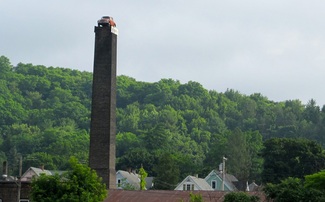
A car on top of a smoke stack? It does get your attention, which is what the business was looking for.

Is it a movie theatre, a church, an off-track betting business or all of these?

This is not a factory made pontoon but two canoes put together with metal struts and a platform. Innovation is still alive! Yet no life jackets which fisherman hardly ever wear.

Just makes you laugh and smile.
